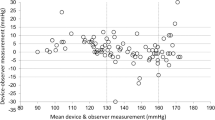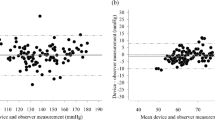Abstract
Introduction
Our aim was to determine the difference between measuring blood pressure (BP) with the mean of three determinations versus the mean of the second and the third determinations in a random general population sample.
Methods
Epidemiological study of the general population aged ≥ 18 from the Health Area of Toledo (Spain), based on the health card database. Three readings of systolic and diastolic BP were taken with validated oscillometric devices OMRON HEM-907. The mean of the three readings was compared with the mean of the second and third readings after discarding the first measurement. We analyzed age, sex, BMI, abdominal obesity, dyslipidemia, diabetes mellitus, smoking and sedentary lifestyle. A descriptive study was conducted, as well as the agreement in the diagnosis of hypertension.
Results
1532 subjects were analyzed (mean age 49.01 ± 15.79 years old, 55.5% women). Response rate 36.3%. The mean systolic BP with three readings was 125.39 ± 17.43 mmHg, versus 124.33 ± 17.07 mmHg with the mean of the second and third readings (mean difference 1.01 ± 4.31; Cohen’s D = 0.059). The mean diastolic BP was 73.93 ± 10.89 versus 73.71 ± 10.93 mmHg with both methods (mean difference 0.19 ± 2.11; Cohen’s D = 0.017). Differences by age, sex, BMI, abdominal obesity, dyslipidemia, diabetes, smoking and sedentary lifestyle were all small (Cohen’s D < 0.08). The agreement between both models for classifying subjects as hypertensive/non-hypertensive showed a Kappa value = 0.936 (McNemar’s test p < 0.001).
Conclusions
Determining the mean of three readings of BP does not make a significant difference in relation to the reading of the second and third measurements in a sample of general population.
Similar content being viewed by others
References
Williams B, Mancia G, Spiering W, Rosei EA, Azizi M, Burnier M, et al. ESC/ESH guidelines for the management of arterial hypertension. Eur Heart J. 2018. https://doi.org/10.1093/eurheartj/ehy339.
Carey RM, Whelton PK, for the 2017 ACC/AHA Hypertension Guideline Writing Committee. Prevention, detection, evaluation, and management of high blood pressure in adults: synopsis of the 2017 American College of Cardiology/American Heart Association Hypertension Guideline. Ann Intern Med. 2018;168(5):351–8.
Brotons Cuixart C, Alemán Sánchez JJ, Banegas Banegas JR, Fondón León C, Lobos-Bejarano JM, Martín Rioboó E, et al. Recomendaciones preventivas cardiovasculares. Actualización PAPPS 2018. Aten Primaria. 2018;50(Supl 1):4–28.
Piepoli MF, Hoes AW, Agewall S, Albus C, Brotons C, Catapano AL, et al. 2016 European Guidelines on cardiovascular disease prevention in clinical practice. The Sixth Joint Task Force of the European Society of Cardiology and Other Societies on Cardiovascular Disease Prevention in Clinical Practice (constituted by representatives of 10 societies and by invited experts). Developed with the special contribution of the European Association for Cardiovascular Prevention and Rehabilitation (EACPR). Eur Heart J. 2016;37(29):2315–81.
Royo-Bordonada MA, Armario P, Lobos Bejarano JM, Pedro-Botet J, Villar Álvarez F, Elosua R, en nombre del Comité Español Interdisciplinario para la Prevencióni Cardiovascular (CEIPC), et al. Adaptación española de las guías europeas de 2016 sobre prevención de la enfermedad cardiovascular en la práctica clínica. Hipertens Riesgo Vasc. 2017;34(1):24–40.
Gabb GM, Mangoni A, Andeson CS, Cowley D, Dowden JS, Golledge J, et al. Guideline for the diagnosis and management of hypertension in adults—2016. Med J Aust. 2016;205(2):58–9.
Piper MA, Evans CV, Burda BU, Margolis KL, O’Connor E, Whitlock EP. Diagnostic and predictive accuracy of blood pressure screening methods with consideration of rescreening intervals: a systematic review for the US Preventive Services Task Force. Ann Intern Med. 2015;162(3):192–204.
Leung AA, Daskalopoulou SS, Dasgupta K, McBrien K, Butalia S, Zarnke KB, for Hypertension Canada, et al. Hypertension Canada’s 2017 guidelines for diagnosis, risk assessment, prevention, and treatment of hypertension in adults. Can J Cardiol. 2017;2017(33):557–76.
The SPRINT Research Group. A randomized trial of intensive versus standard blood-pressure control. N Engl J Med. 2015;373(22):2103–16.
Kjeldsen SE, Lund-Johansen P, Nilsson PM, Mancia G. Unattended blood pressure measurements in the Systolic Blood Pressure Intervention Trial. Implications for entry and achieved blood pressure values compared with other trials. Hypertension. 2016;67:808–12.
Rodríguez Padial L, Segura Fragoso A, Alonso Moreno FJ, Arias MA, Villarín Castro A, Rodríguez Roca GC. Diferencias de presión arterial entre una toma y la media de 3 tomas medidas automáticamente. Estudio SPRINT. Med Clin (Barc). 2017;149(2):72–4.
Rodríguez-Roca GC, Rodríguez-Padial L, Alonso-Moreno FJ, Segura-Fragoso A, Villarín-Castro A, Rodríguez-García ML, en representación del grupo de trabajo RICARTO, et al. Justificación, objetivos y diseño metodológico del estudio RICARTO (RIesgo CARdiovascular y eventos cardiovasculares en la población general del área sanitaria de TOledo). Semergen. 2018;44(2):107–13.
Rodríguez-Roca GC, Segura-Fragoso A, Villarín-Castro A, Alonso-Moreno FJ, Rodríguez-Padial L, Rodríguez-García ML, en representación del grupo de trabajo RICARTO, et al. Características de la población general incluida en el estudio RICARTO (RIesgo CARdiovascular y eventos cardiovasculares en la población general del área sanitaria de TOledo): resultados con los primeros 1.500 individuos incluidos en el estudio. Semergen. 2018;44(3):180–91.
Orueta R, Toledano P, Gómez-Calcerrada RM. Actualización en Medicina de Familia: Cumplimiento terapéutico. Semergen. 2008;34(5):235–43.
Omboni S, Riva I, Giglio A, Caldara G, Groppelli A, Parati G. Validation of the Omron M5-I, R5-I and HEM-907 automated blood pressure monitors in elderly individuals according to the International Protocol of the European Society of Hypertension. Blood Press Monit. 2007;12:233–42.
El Assaad MA, Topouchian JA, Darné BM, Asmar RG. Validation of the Omron HEM-907 device for blood pressure measurement. Blood Press Monit. 2002;7:237–42.
Parati G, Stergiou G, O’Brien E, Asmar R, Beilin L, Bilo G, on behalf of the European Society of Hypertension Working Group on Blood Pressure Monitoring and Cardiovascular Variability, et al. European Society of Hypertension practice guidelines for ambulatory blood pressure monitoring. J Hypertens. 2014;32:1359–66.
Banegas JR, Ruilope LM, de la Sierra A, Vinyoles E, Gorostidi M, de la Cruz JJ, et al. Relationship between clinic and ambulatory blood-pressure measurements and mortality. N Engl J Med. 2018;378(16):1509–20.
Campbell NRC, Berbari AE, Cloutier L, Gelfer M, Kenerson JG, Khalsa TK, et al. Policy statement of the World Hypertension League on noninvasive blood pressure measurement devices and blood pressure measurement in the clinical o community setting. J Clin Hypertens. 2014;16(5):320–2.
Weber MA, Schiffin EL, White WB, Mann S, Lindholm LH, Kenerson JG, et al. Clinical practice guidelines for the management of hypertension in the community. A statement by the American Society of Hypertension and the International Society of Hypertension. J Hypertens. 2014;32:3–15.
Myers MG, Kaczorowski J, Dolovich L, Tu K, Paterson JM. Cardiovascular risk in hypertension in relation to achieved blood pressure using automated office blood pressure measurement. Hypertension. 2016;68(4):866–72.
Drawz PE, Abdalla M, Rahman M. Blood pressure measurement: clinic, home, ambulatory, and beyond. Am J Kidney Dis. 2012;60(3):449–62.
Vinyoles E, Cecilia M, García-Alfaro M, Vera M, Fernández-San Martín MI. To wait or not to wait 1 minute between office blood pressure readings. Blood Press Monit. 2014;19(4):203–7.
Giorgini P, Weder AB, Jackson EA, Brook RD. A review of blood pressure measurement protocols among hypertension trials: implications for “evidence-based” clinical practice. J Am Soc Hypertens. 2014;8(9):670–6.
Nwankwo T, Gindi R, Chen TC, Galinsky A, Miller I, Terry A. Comparison of blood pressure measurements obtained in the home setting: analysis of the Health Measures at Home Study. Blood Press Monit. 2016;21(6):327–34.
Benmira A, Perez-Martin A, Schuster I, Aichoun I, Coudray S, Bereski-Reguig F, et al. From Korotkoff and Marey to automatic non-invasive oscillometric blood pressure measurement: does easiness come with reliability? Expert Rev Med Devices. 2016;13(2):179–89.
Author information
Authors and Affiliations
Corresponding author
Ethics declarations
Funding
This study was funded from 2011 to 2013 by the Government of Castilla-La Mancha, through a Grant for Biomedical and Health Sciences Research (file number PI-2010/043) from Castilla-La Mancha Social and Health Care Foundation (FISCAM). The Foundation of the Spanish Society of Primary Care Physicians (SEMERGEN) has been collaborating since 2013 in the funding of the RICARTO study with an unconditional grant.
Conflict of interest
The authors declare that there is no conflict of interest.
Rights and permissions
About this article
Cite this article
Villarín Castro, A., Segura Fragoso, A., Alonso Moreno, F.J. et al. Mean Blood Pressure of the General Population with the Mean of Three Measurements Versus the Mean of the Second and Third Measurements. Ricarto Study. High Blood Press Cardiovasc Prev 26, 391–397 (2019). https://doi.org/10.1007/s40292-019-00338-0
Received:
Accepted:
Published:
Issue Date:
DOI: https://doi.org/10.1007/s40292-019-00338-0




